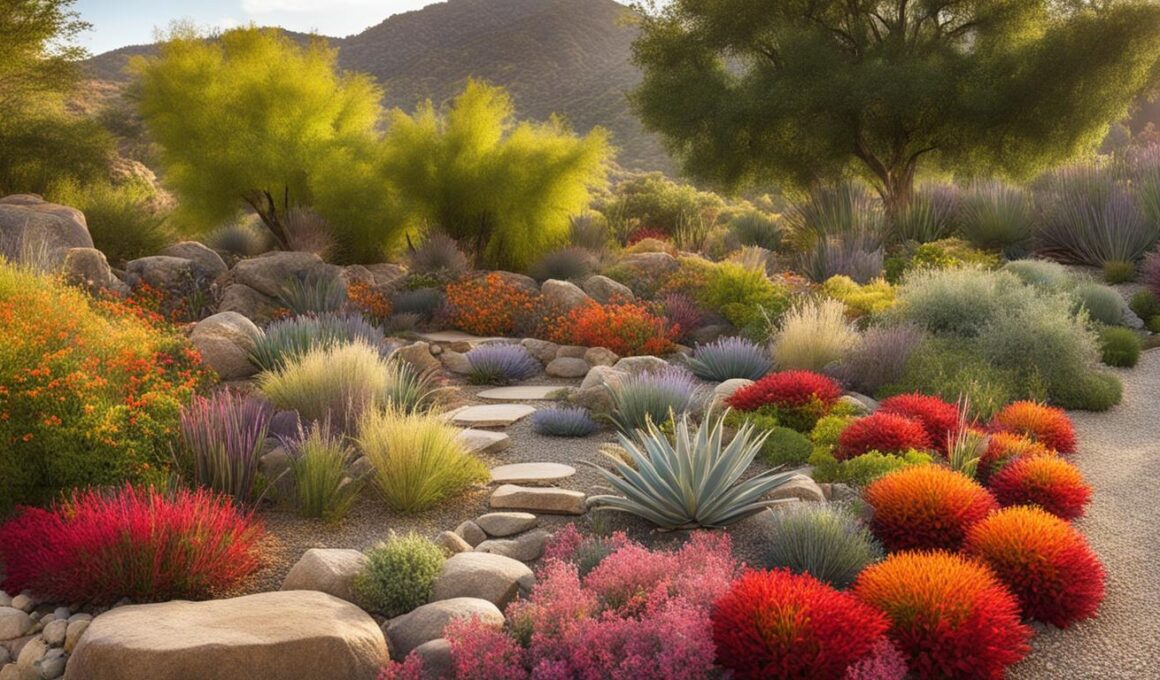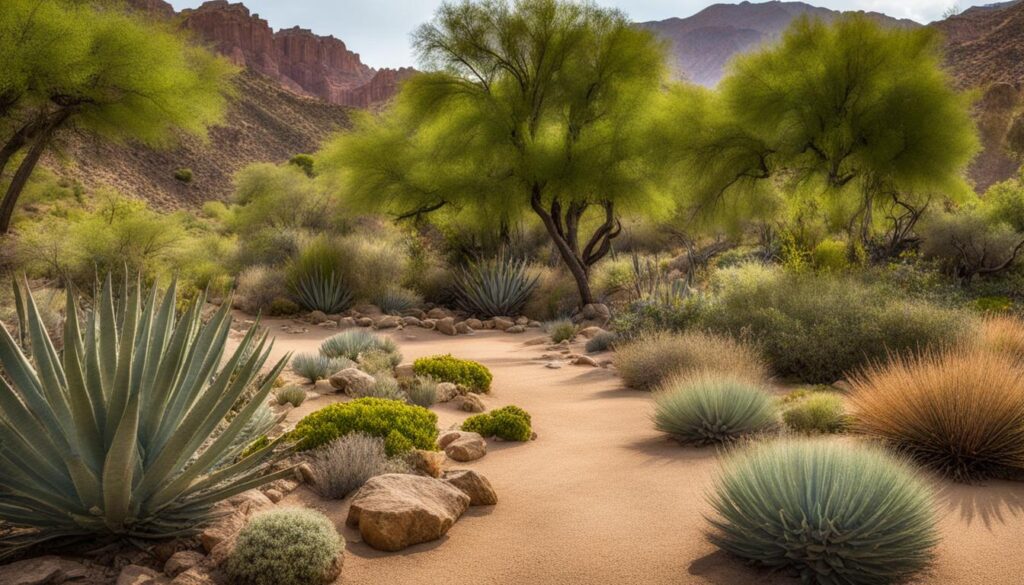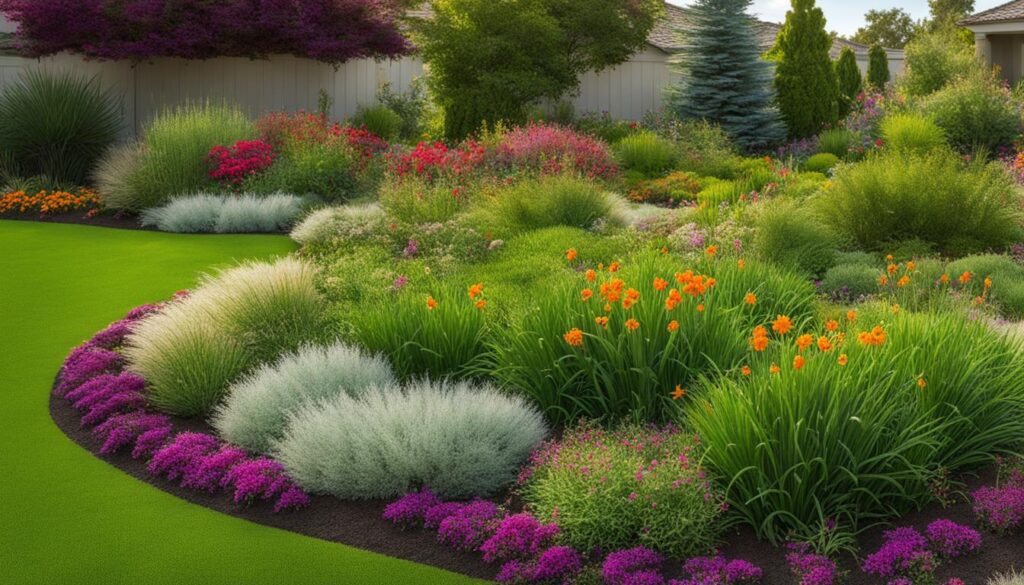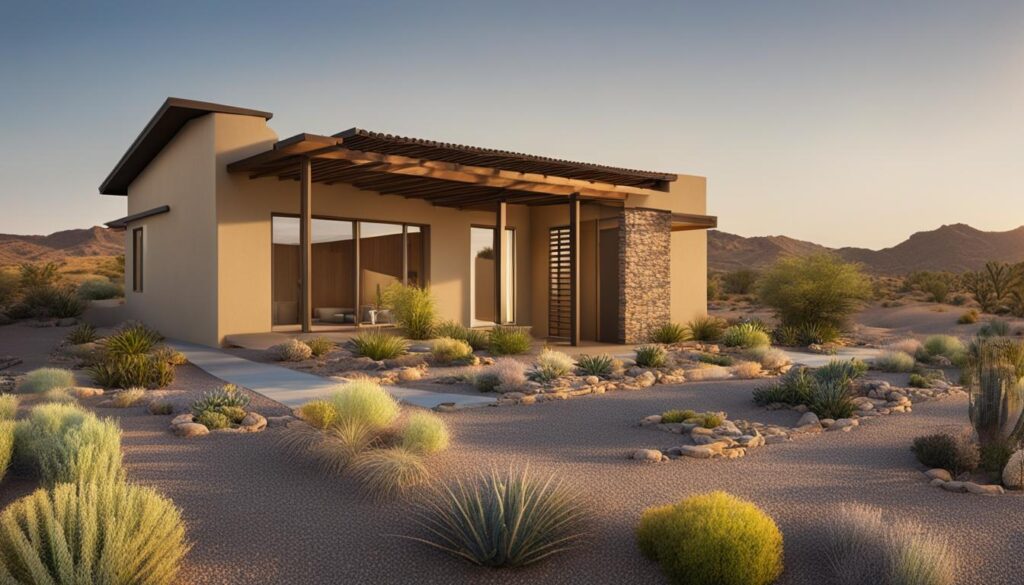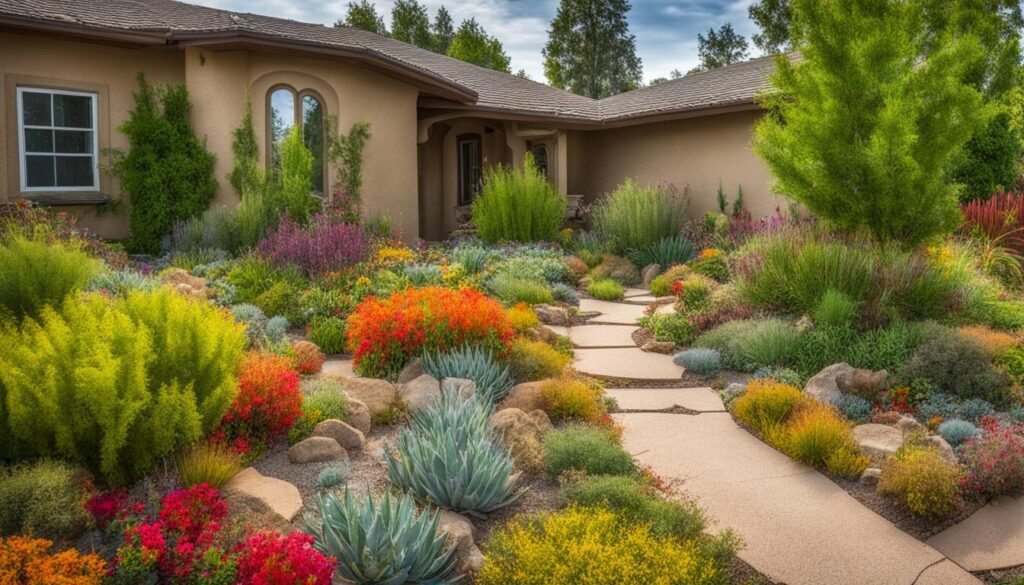Are you concerned about water conservation and looking for an eco-friendly landscaping option? In this article, we will explore the differences between xeriscaping and traditional landscaping when it comes to water use. By understanding the benefits and principles of xeriscaping, you can make an informed decision for your outdoor space that will not only conserve water but also save you money in the long run.
Key Takeaways
- Xeriscaping refers to low-water landscaping that can save around 50% of water used outdoors compared to traditional landscaping.
- At least 40 states in the U.S. may face freshwater shortages by 2024, highlighting the importance of water conservation.
- Xeriscaping can increase property values by up to 15% and save money on monthly utilities.
- Using native plants, efficient irrigation methods, and grouping plants with similar water needs are key principles of xeriscaping.
- Xeriscaping reduces water usage, minimizes emissions, promotes biodiversity, and creates a sustainable environment.
The Benefits of Xeriscaping
Xeriscaping offers numerous benefits that make it a smart choice for your landscaping needs. By implementing xeriscaping techniques, you can enjoy the following advantages:
- Water Conservation: Xeriscaping can reduce outdoor water usage by about 50%, helping to conserve our precious freshwater resources. This is especially important in areas facing water shortages.
- Increased Property Value: Implementing xeriscaping can increase property values by up to 15%. A well-designed xeriscape not only enhances the curb appeal of your home but also attracts environmentally conscious buyers.
- Cost Savings: Xeriscaping proves to be cost-effective in the long run. While there may be an upfront investment ranging from $5 to $20 per square foot, the savings on monthly utility bills and maintenance costs make it a worthwhile choice.
- Eco-Friendly Landscaping: Xeriscaping is an environmentally conscious landscaping option that reduces the need for chemical fertilizers and pesticides. By using native plants, xeriscaping supports local ecosystems and promotes biodiversity.
With xeriscaping, you can create a beautiful and sustainable landscape while also contributing to water conservation efforts. The benefits of xeriscaping extend beyond your property, making it a smart and responsible landscaping choice for homeowners.
How Xeriscaping Works
Xeriscaping is a landscaping approach that aims to minimize water usage while creating a beautiful and sustainable outdoor space. By following certain principles and utilizing specific techniques, you can successfully implement xeriscaping in your yard.
1. Choose Native Plants
Native plants play a vital role in xeriscaping. These plants have adapted to the local climate and are naturally more resistant to drought. They require less water and are better suited to thrive in your specific region. By selecting native plants for your xeriscaped yard, you can reduce the need for excessive irrigation and maintain a healthy and vibrant landscape.
2. Implement Efficient Irrigation
Efficient irrigation is key to xeriscaping. Instead of traditional sprinkler systems that distribute water over a large area, consider using drip systems or soaker hoses. These methods deliver water directly to the base of the plants, minimizing evaporation and ensuring that water reaches the plants’ roots where it is needed most. By using efficient irrigation techniques, you can significantly reduce water waste and improve the overall water conservation of your xeriscaped yard.
3. Incorporate Drought-Tolerant Plants
Xerophytes, also known as drought-tolerant plants, are an essential component of xeriscaping. These plants have adapted to arid conditions and can thrive with minimal water requirements. By incorporating drought-tolerant plants into your xeriscaped landscape, you can create a visually appealing yard that requires less irrigation and maintenance. Examples of drought-tolerant plants include succulents, ornamental grasses, and many native wildflowers.
By following these principles and utilizing native plants, efficient irrigation methods, and drought-tolerant plants, you can create a xeriscaped yard that is not only aesthetically pleasing but also conserves water and supports the local environment.
The Environmental Impact of Xeriscaping
Xeriscaping plays a crucial role in water conservation, as it can reduce water usage by 50% or more. By minimizing the need for water-intensive plants and grass lawns, xeriscaping helps alleviate the strain on water sources. This is especially important considering the increasing freshwater shortages that many states in the U.S. may face in the near future. With only about 3% of Earth’s water being freshwater, every drop counts. Xeriscaping allows us to make a significant impact in reducing water waste and promoting a more sustainable water supply.
Not only does xeriscaping conserve water, but it also has a positive impact on reducing emissions. Traditional lawn maintenance equipment, such as lawn mowers and leaf blowers, contribute to air pollution. By minimizing the need for frequent mowing and maintenance, xeriscaping helps reduce emissions and improve air quality. This makes it a more environmentally friendly landscaping option that contributes to a healthier planet.
In addition to water conservation and reduced emissions, xeriscaping also promotes biodiversity. By using native plants, xeriscaping creates habitats that support local wildlife and ecosystems. Native plants are well-adapted to the local environment and provide food and shelter for various species, including pollinators like bees and butterflies. Xeriscaping allows us to create beautiful landscapes that not only conserve water but also contribute to the preservation of biodiversity.
Benefits of Xeriscaping for Biodiversity:
- Provides habitats for local wildlife
- Supports pollinators like bees and butterflies
- Promotes the preservation of native plant species
- Creates a healthier and more sustainable ecosystem
With its focus on water conservation, reduced emissions, and support for biodiversity, xeriscaping offers a holistic approach to landscaping that benefits both the environment and our communities. By embracing xeriscaping, you can contribute to the preservation of our natural resources and create a more sustainable and beautiful outdoor space.
The Cost of Xeriscaping
Xeriscaping offers a multitude of benefits, but it’s essential to consider the upfront investment and long-term savings associated with this eco-friendly landscaping option. While the initial cost of xeriscaping can range from $5 to $20 per square foot, the long-term savings make it a cost-effective choice. Traditional landscaping, on the other hand, averages around $4.50 to $17 per square foot but can be more expensive to maintain.
One of the significant advantages of xeriscaping is the reduction in water bills. By designing a landscape that requires little to no irrigation, you can save on monthly utility costs. Additionally, xeriscaping minimizes the need for lawn maintenance, such as mowing and fertilizing, resulting in further savings over time.
It’s important to note that xeriscaping pays off in the long run. While the upfront investment may seem higher than traditional landscaping, the long-term benefits, including water conservation and reduced maintenance costs, outweigh the initial expenses. Choosing xeriscaping not only helps you save money but also contributes to a more sustainable environment.
Challenges and Considerations of Xeriscaping
While xeriscaping offers numerous benefits, it is important to consider the potential challenges and factors to keep in mind before embarking on this eco-friendly landscaping journey.
HOA Regulations
One challenge homeowners may face is navigating the landscape guidelines and restrictions imposed by their Homeowners’ Association (HOA). Some HOAs may have specific rules regarding landscaping design, including the types of plants allowed. However, it is worth noting that some states prohibit HOAs from enforcing policies that restrict low-water landscaping. It is advisable to familiarize yourself with your specific HOA’s regulations and potentially work with them to find common ground in implementing xeriscaping principles.
Visual Changes
Transitioning from a traditional lawn to a xeriscape garden may bring significant visual changes to your outdoor space. Xeriscaping utilizes native plants that are adapted to the local climate and require less water, which can result in a different aesthetic compared to the traditional lush green lawn. It is important to embrace the natural beauty and diversity that xeriscaping brings, as it contributes to a more sustainable and environmentally conscious landscape.
Time for Establishment
Patience is key when it comes to xeriscaping. Native plants require time to establish and thrive in their new environment. Initially, newly planted landscapes may appear sparse as the plants take root and grow. It is crucial to understand that it takes time for the plants to adapt and flourish. With proper care and maintenance, your xeriscape garden will eventually become a vibrant and resilient ecosystem that requires minimal water and maintenance.
Conclusion
Xeriscaping offers a sustainable and eco-friendly approach to landscaping that promotes water conservation, cost savings, and a healthier environment. By choosing xeriscaping, you are contributing to the efforts of water conservation and reducing your carbon footprint.
With its focus on using native plants and efficient irrigation methods, xeriscaping allows you to design a beautiful landscape that requires less water and maintenance. You can enjoy significant cost savings on your monthly utilities and long-term maintenance expenses.
While the upfront investment for xeriscaping may be higher than traditional landscaping, the benefits far outweigh the initial costs. Not only will you be saving water and money, but you will also be creating a sustainable and environmentally conscious yard that supports local ecosystems and promotes biodiversity.
Whether you live in a drought-prone area or simply want to make a positive impact on the environment, xeriscaping is a practical and responsible choice. Embrace the beauty of xeriscaping and enjoy a landscape that is both visually appealing and environmentally friendly.





